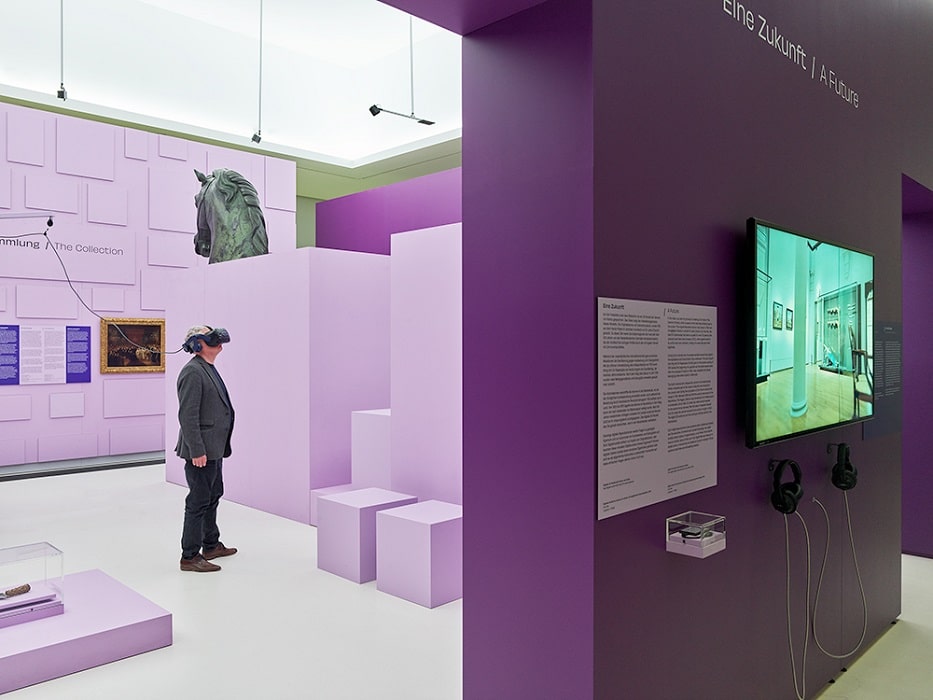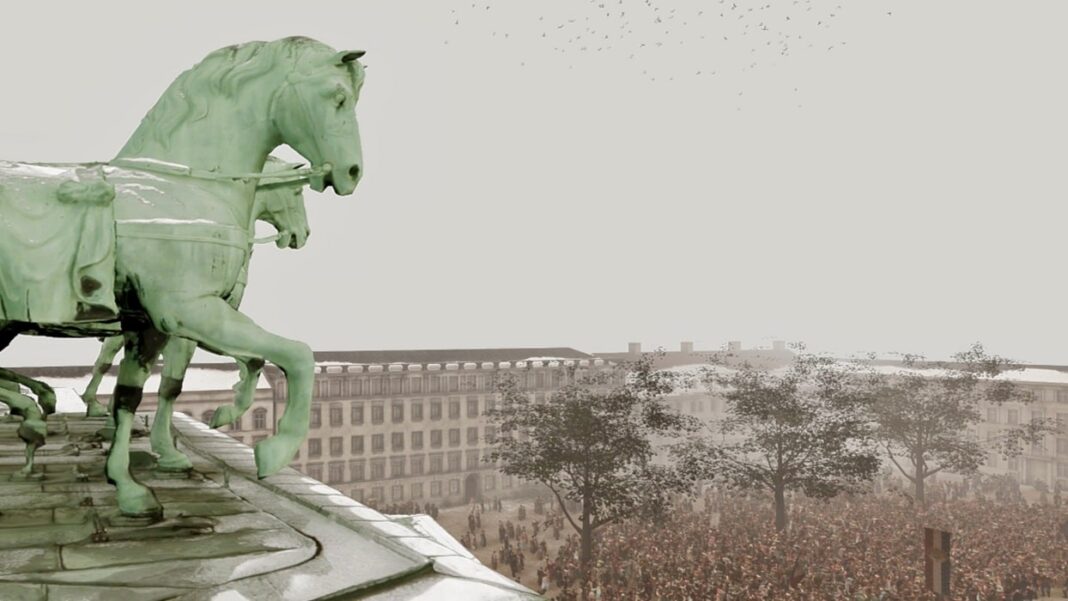In the exhibition “Loot . 10 Stories”, initiated by the Mauritshuis in The Hague, the Humboldt Forum Berlin presents from 22. March 2024, ten case studies focused on looted art across three historical epochs: the Napoleonic Wars, the colonial era, and Nazi Germany. All the objects on show have their own provenance stories, which here stand in for countless others. In an artistic intervention, guest curators and creative directors Eline Jongsma and Kel O’Neill bring these stories to life using videos, virtual reality, and texts, showing possible approaches to objects like these in the museum context. Some of these artefacts are from Berlin collections in the Stadtmuseum Berlin, the Ethnologisches Museum, and the Gipsformerei (Replica Workshop). A Späti on 22 March and a Day of Debate on 23 March will also address the themes of looting, restitution, and museums working together on addressing the provenance of artefacts.
Image above: Still from the VR Quadriga on top of the Brandenburger Tor, © Jongsma + O’Neill
Art and other objects are mirrors of historical and social development. Sometimes they tell of love, solidarity, or the future. But they also regularly tell stories of violence, abuse, and robbery. Napoleon reinforced his own power by displaying looted art treasures at his Musée Napoleon. Hitler had art confiscated to stock his planned museum. And particularly in the context of their years of colonial rule and exploitation, the European powers looted countless cultural belongings from all over the world and shipped them to Europe.
The exhibition Loot. 10 Stories examines different aspects of looted art and explores the implications. It was initiated by the Mauritshuis in The Hague, where the exhibition opened in 2023. In ten case studies it explores the past as well as the future of unlawfully appropriated objects, touching on issues like provenance research, restitution, and how museums see themselves today. The exhibition focuses on three historical periods that reflect the collections of the participating museums and institutions from the Netherlands, Germany, and France: the Napoleonic Wars, European colonialism, and the Nazi period. This international cooperation between different institutions shows varying perspectives and approaches to the exhibited objects.

Eline Jongsma and Kel O’Neill, guest curators and creative directors of the exhibition, embark upon a search for clues. In their artistic intervention they explore the stories behind the objects and the gaps in our knowledge of their provenance. They use virtual reality, video installations, and a digital 3D model, encouraging visitors to reflect on the issues: In what contexts were objects looted and how did they find their way into the museums? How do museums deal with looted artworks today? Both the design and the narrative of the exhibition are fundamental to its basic premise, which is to offer insights into provenance research and to posit possible ways of dealing with looted art and restitution in the future, as well as to show how returned objects can remain on display in museums. The exhibition also looks at objects that have already been returned or where the process of restitution is under way and at objects whose history cannot be fully reconstructed or whose rightful owners cannot be found. There are also objects for which, despite intensive research, it has not yet been conclusively clarified that they were unlawfully appropriated – as in the case of the Anet commode from the Stadtmuseum Berlin.
Objects, artefacts, and cultural belongings in the exhibition
The exhibition includes three items on loan from the Stadtmuseum Berlin collection: the Märkisches Museum’s “Special Silver Inventory”, the Anet commode from the set of furniture known as the Reichsbank collection, and the horse’s head from the quadriga sculpture on the Brandenburg Gate. The Ethnologisches Museum – Staatliche Museen zu Berlin provided an ornate wooden staff from Suriname and a Kris dagger from Bali. The Gipsformerei – Staatliche Museen zu Berlin contributed replicas and moulds of the Benin Bronzes. Paintings by Rembrandt and Paulus Potter from the holdings of the Mauritshuis are also on display, as well as a video about the creation of a 3D model of the Cannon of Candy, an ornamental cannon inlaid with jewels that was kept in Amsterdam’s Rijksmuseum but has in the meantime been returned to Sri Lanka. The exhibition also includes a painting by Jan Mijtens loaned from the Musée des Beaux-Arts de Rennes
Programme of events for the exhibition
“Ten among thousands”: the case studies shown here are just a few of many other possible object histories. The programme of events accompanying the exhibition therefore seeks to unfold the complexity of the theme and to explore background information and discourses relating to the issue of looted art.
For the event in the Späti series, Loot: A Staff from Suriname on 22 March, guests are Onias Landveld, a Dutch artist with Surinamese roots, and Andrea Scholz, curator at the Ethnologisches Museum. Landveld has taken a close look at one of the exhibition’s key objects: a staff (c.1900) that was taken from the indigenous Maroons in Suriname during the Dutch colonial period and passed on to the Ethnologisches Museum in Berlin in 1903 by a collector, and which is still held by the museum today. More information is available here.

On the Day of Debate on Looting, Restitution, and Collaboration: 10 of 1,000 Stories: Loot on 23 March, experts and scholars will provide insights into provenance research, share their knowledge, and point out possible solutions for how to address and present the history of artefacts in future. During the morning, visitors can hear both artistic and academic contributions to the exhibition; during the afternoon, they can pose their own questions. With Onias Landveld, Eline Jongsma, Kel O’Neill, Regina Stein, Alexis von Poser, Hartmut Dorgerloh, and others.
This exhibition was initiated by the Mauritshuis in The Hague and developed together with guest curators and creative directors Jongsma and O’Neill. The project was realized in cooperation with the Stiftung Humboldt Forum im Berliner Schloss, the Stiftung Stadtmuseum Berlin, and the Ethnologisches Museum and the Museum für Asiatische Kunst at the Staatliche Museen zu Berlin – Preußischer Kulturbesitz. It is supported by the Federal Government Commissioner for Culture and the Media on the basis of a decision by the German Federal Parliament.
WHEN?
Friday, 22. March 2024 – Sunday, 26. January 2025
Opening hours: Daily from 10:30 am until 6:30 pm
Closed on Tuesdays
Späti: A Staff from Suriname, Friday, 22 March, 4:30 – 8:30 pm
Day of Debate: Saturday, 23 March, 11 am – 6 pm
WHERE?
Room 312,
Humboldt Forum
Schloßplatz
10178 Berlin
COSTS?
Entrance free






